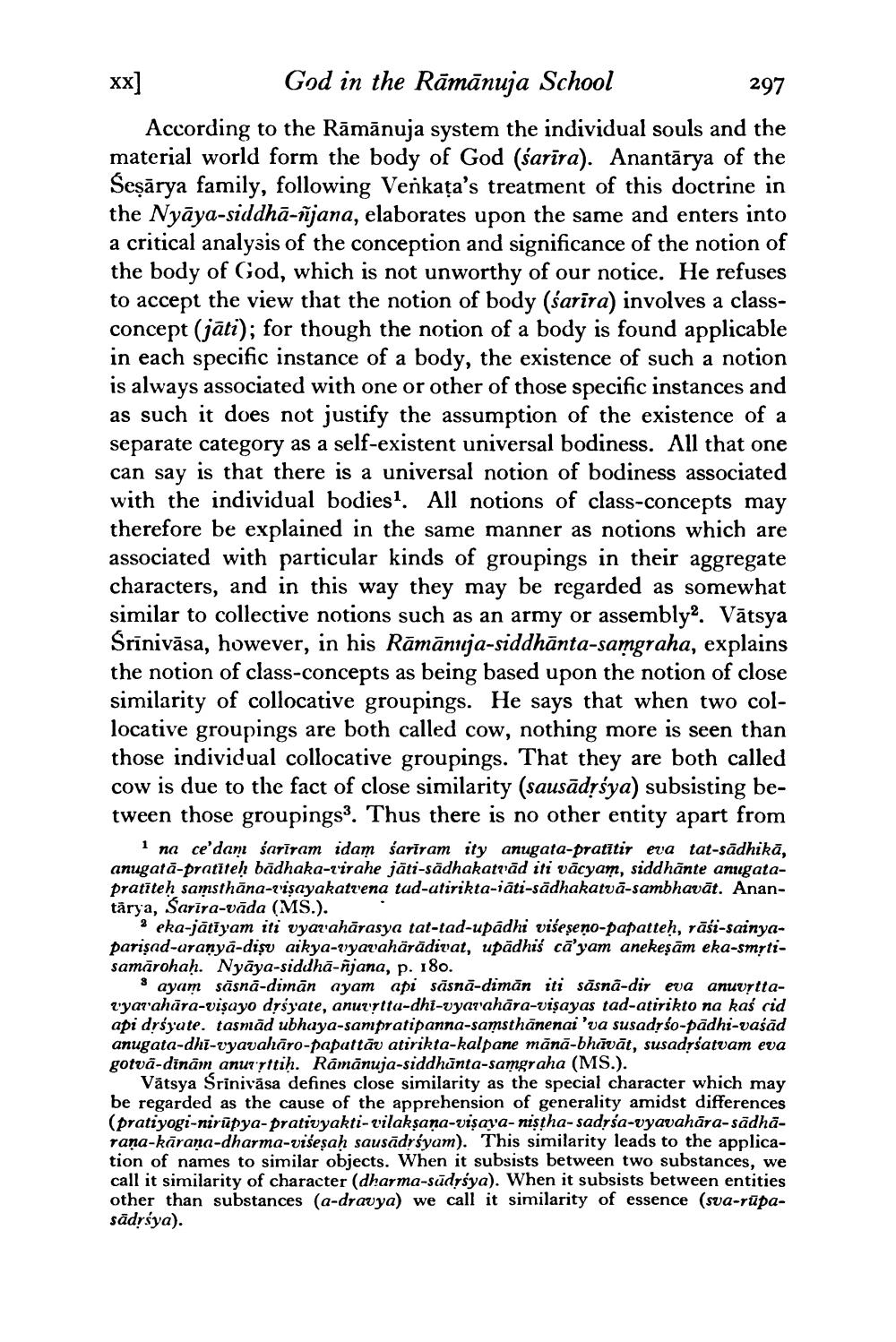________________
xx] God in the Rāmānuja School
297 According to the Rāmānuja system the individual souls and the material world form the body of God (śarīra). Anantārya of the Seșārya family, following Venkata's treatment of this doctrine in the Nyāya-siddhā-1ījana, elaborates upon the same and enters into a critical analysis of the conception and significance of the notion of the body of God, which is not unworthy of our notice. He refuses to accept the view that the notion of body (sarira) involves a classconcept (jāti); for though the notion of a body is found applicable in each specific instance of a body, the existence of such a notion is always associated with one or other of those specific instances and as such it does not justify the assumption of the existence of a separate category as a self-existent universal bodiness. All that one can say is that there is a universal notion of bodiness associated with the individual bodies?. All notions of class-concepts may therefore be explained in the same manner as notions which are associated with particular kinds of groupings in their aggregate characters, and in this way they may be regarded as somewhat similar to collective notions such as an army or assembly2. Vātsya Śrīnivāsa, however, in his Rāmānuja-siddhānta-samgraha, explains the notion of class-concepts as being based upon the notion of close similarity of collocative groupings. He says that when two collocative groupings are both called cow, nothing more is seen than those individual collocative groupings. That they are both called cow is due to the fact of close similarity (sausādịśya) subsisting between those groupings3. Thus there is no other entity apart from
i na ce'dan sarītam idam sariram ity anugata-pratitir eva tat-sādhikā, anugatā-pratiteh bādhaka-t'irahe jāti-sādhakatrād iti vācyam, siddhante anugatapratiteh samsthāna-visayakatrena tud-atirikta-iāti-sādhakatvā-sambhavāt. Anantārya, Sarira-vāda (MS.).
> eka-jātīyam iti vyavahārasya tat-tad-upādhi višeşeņo-papatteḥ, rāśi-sainyaparişad-aranya-dişu aikya-ryavahārādivat, upādhis ca'yam anekeşām eka-smrtisamārohah. Nyāya-siddha-njana, p. 180.
8 ayam sāsnā-diman ayam api sāsnā-dimān iti sāsna-dir eva anuvrttaz'yarahāra-vişayo drsyate, anurrtta-dhi-vyarahāra-visayas tad-atirikto na kaś cid api drsyate. tasmād ubhaya-sampratipanna-samsthānenai 'va susadyśo-pādhi-vaśād anugata-dhi- yavahāro-papattāv atirikta-kalpane mānā-bhāvāt, susadrsatvam eva gotvá-dinām anutritih. Rāmānuja-siddhūnta-samgraha (
MS.). Vātsya Srinivasa defines close similarity as the special character which may be regarded as the cause of the apprehension of generality amidst differences (pratiyogi-nirūpya-prativyakti-vilaksana-visaya- nistha-sadyśa-vyavahāra-sādhārana-kāraṇa-dharma-višeşah sausādrśyam). This similarity leads to the application of names to similar objects. When it subsists between two substances, we call it similarity of character (dharma-sūdrsya). When it subsists between entities other than substances (a-dravya) we call it similarity of essence (sva-rūpasādrsya).




